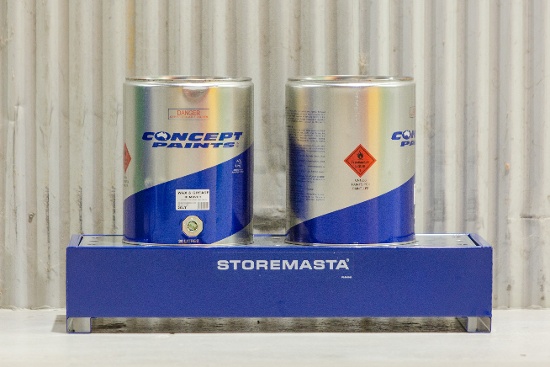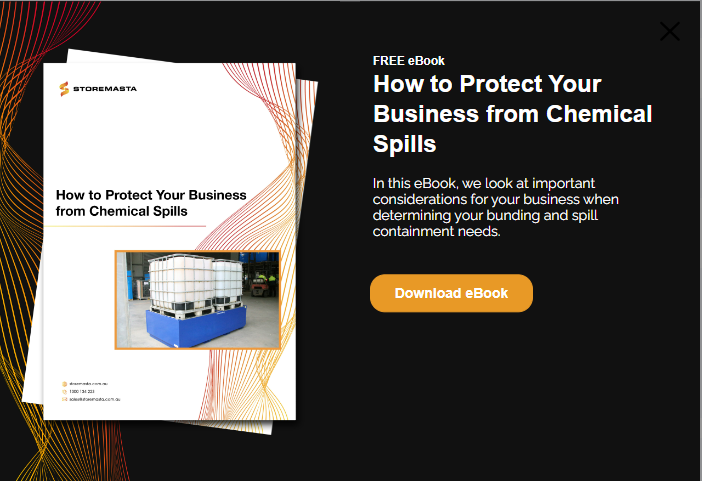We all understand the safety concerns when you’re dealing with flammable liquids in the workplace. Namely, the risk of your substances igniting if there is a leak, spill or release of vapours. While all dangerous goods and hazardous chemicals must be controlled and contained, the risk of fire, explosion and flashback with flammable liquids is a real safety concern that needs to be addressed to prevent damage to people, property and the environment. In this post, we’ll be looking at some key precautions and preventative measures to help you avoid dangerous flammable liquid spills in your own organization.
Why Do Flammable Liquid Spills Pose a Risk?
Flammable liquids, if accidentally leaked or spilled in a workplace, can pose a range of risks that can potentially cause enormous damage to your workplace and the surrounding area.
There are a range of risks that may occur, including:
- Physical injury if staff slip or fall due to the leakage
- Release of flammable vapours posing a fire or explosion risk
- Flammable vapours travelling throughout a workplace can lead to incidents of flashback
- Incompatible chemicals may come in contact with flammable liquids, causing a reaction
- Release of flammable liquids into the environment, through soil, drains or uncontained spillage
- Flammable liquids and their fumes affecting health of workers who are exposed to them
Requirements and Regulations
While it is the duty of every workplace to provide a safe environment, there are specific duties that must be abided by to ensure safety with flammable liquids and potential spills.
This includes provision for safety precautions and controls for a wide range of topics including, but not limited to:
- Operational and personnel safety
- Fire protection
- Emergency management
- Package storage design and construction
- Package storage practices
- Safe handling practices
- Fuel dispensing
- Signage and labelling
- Register and manifest of hazardous chemicals
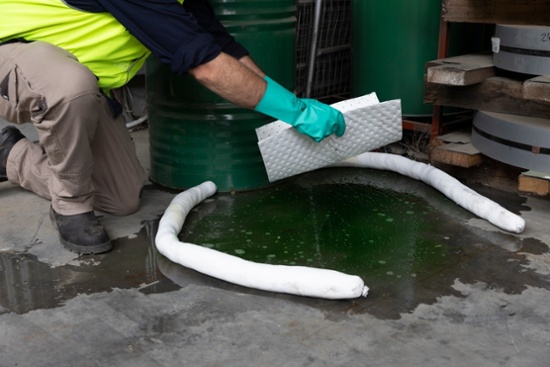
You can increase safety when dealing with flammable liquid spills by referring to WHS and Australian Standards.
There are several key documents which can assist workplaces in achieving safety and compliance with Class 3 Flammable Liquids.
Some of these helpful documents include:
- Model Work Health and Safety Regulations (particularly Chapter 7 Hazardous Chemicals)
- A Guide for Flammable and Combustible Liquids under the Work Health and Safety Act 2011
- Safe Work Australia Code of Practice: Managing Risks of Hazardous Chemicals in the Workplace
- Australian Standard AS 1940 – The Storage and Handling of Flammable and Combustible Liquids
Is your spill kit compliant?
Access your free Spill Kit Checklist
Key Precautions to Consider with Flammable Liquid Spills
While there are countless requirements that relate to the handling and storage of flammable liquids and the management of spills, there are some key points to consider for workplace safety.
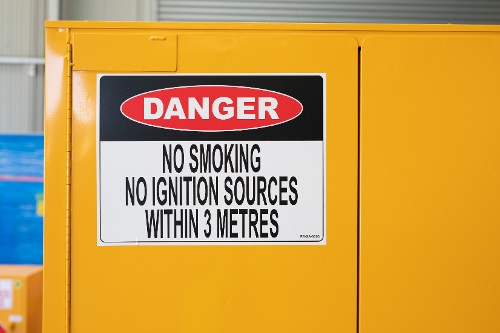
The key risk with flammable spills is ignition of the flammable vapours that are emitted from the chemical.
These precautions include:
- Substituting or limiting the volume of flammable liquids at the worksite
- Training staff to understand flammable liquids safety and how to use engineering controls, such as storage and handling equipment
- Provision of suitable PPE that is fit-for-purpose, properly maintained and available for staff in a designated and dedicated cabinet
- Monitoring of air quality to ensure the legal limits of the workplace exposure standards are met for worker health and safety
- Compliant storage of flammable liquids and other hazardous chemicals or dangerous goods at the site
- The maintenance and implementation of chemical handling equipment
- Exclusion of ignition sources in all areas of the workplace that store, handle, transfer or use these chemicals
- Isolation from protected and public places to limit the degree of harm posed by a fire in a flammable liquids store
- Installation of secondary containment systems including floor bunding, portable bunding or other options to prevent the spread of spillage
- Location and maintenance of flammable liquid storage areas to reduce risk of leaks, spills and vapour build up
Always ensure flammable liquid drums are bunded to prevent leaks and spills.
- Creation of a spill response plan and induction of a spill response team who are suitably equipped to manage a Class 3 spill
- Development of fire and emergency procedures
- Implementation of alarms, fire extinguishers and firefighting systems
- Documentation of chemicals onsite, with respect to current SDS, hazardous chemical registers and hazardous chemical manifests (if applicable)
- Provision and training for all first aid and emergency decontamination equipment
- Regular inspection and maintenance of controls to ensure every effort is being made to prevent leaks and spills
- Checking the spill sump daily to ensure the equipment is in good condition and there are no chemicals accumulating in the sump
- Regular risk assessments to ensure that there are no new or unidentified hazards in the workplace
- Record keeping for a range of incidents including: staff training and retraining; in service inspections, maintenance and repairs; fires, significant spillage, injury, accident, dangerous occurrence and other incidents
IMPORTANT: While selecting and installing flammable storage is essential for safety and the prevention of spills, it’s also important to inspect and clean-out your cabinets and outdoor storage containers to minimise accidental releases and vapour build up. Read our blog to learn more about housekeeping practices for your Class 3 cabinets.
Required Actions for Spills
When dealing with a flammable liquids spill, there are many steps to take to decrease risk.
These include:
- Isolating the area
- Notifying the Spill Response Team
- Assessing the size of the spill (minor – inhouse management, major – requires emergency response)
- Putting on the appropriate PPE for the spill
- Applying natural ventilation to disperse vapours, if safe to do so
- Shutting off of ignition sources that may spark a fire
- Identification of potential hazards including incompatible substances or environmental pollution
- Containment of spill including plugging of leaking equipment or barriers to prevent the liquid seeping into drains or other areas of the workplace
- Clean-up of the spills including the use of suitable spill kits with compatible materials for class 3 liquids
- Decontamination of the site to prevent flammable liquids or vapours from remaining
- Safe disposal of contaminated chemicals and waste products
- Recording of the spill incident
- Meeting and retraining to minimise likelihood of another spill incident
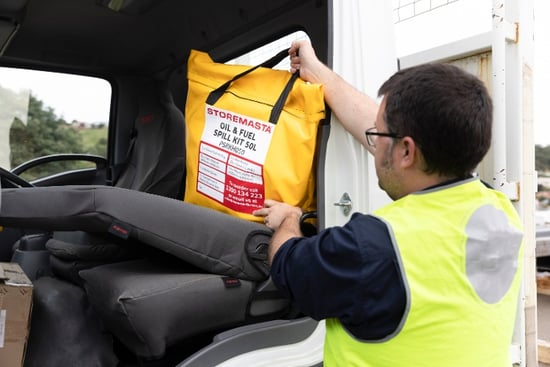
Flammable spills can happen anywhere that Class 3 liquids are used, including your fleet.
REMEMBER: There are many spill kits on the market, with various materials, equipment and capacities. Read our blog to learn more about choosing and maintaining a spill kit for your operations.
Leaking Packages
When dealing with a chemical spill, there are often times that a leaking package can be repackaged into a new container to save chemical wastage.
If a flammable package, such as a container, bottle or drums, has a leak, the Australian Standard 1940 states that it can be placed into a larger container to stop the leak and contain the chemical spillage.
You may place the leaking chemical package in a larger container or transfer it to new packaging. However, keep in mind that this new container will have to be properly labelled to ensure all staff are aware of the new contents.
When it comes to managing small spills, the leaked chemical needs to be collected, absorbed or diluted if appropriate – then put into a waste container and transferred for safe disposal.
IMPORTANT: Empty containers that have held flammable liquids can still produce hazards such as fire or explosion due to the remaining chemical residue. Find out more about the hazards by checking out our popular post, Do Empty Containers Still Pose a Risk.
Emergency Plan
When developing emergency plans and evacuation procedures for your workplace, every possible scenario must be considered to achieve optimum protection for your organisation and community. This includes the possibility of both minor and major flammable liquid spills.
Emergency services need to be notified if:
- Flammable liquids have spread or could spread, beyond your boundary
- The spill is beyond the capabilities of your team to contain and clean-up safely
- Your protective equipment is insufficient for the situation
- Staff have not been properly trained or experienced to manage the spill
- There is a risk to people, whether that is your staff or the public
REMEMBER: PPE must be suitable for the chemicals at your site. It must also be free of wear and tear to ensure safety for your team. Learn more about Class 3 PPE by reading our blog.
Fire Fighting Equipment
If the spill is within your capabilities, there is still the very real possibility that a fire may erupt.
Every workplace must have a plan in place that allows for suitable fire protection systems that will adequately control the hazard.
Materials must be suitable for the conditions of use and be compatible with the flammable liquids that you’re storing. Particular attention must be paid to cater for foam concentration, mixing ratios and applicable methods and rates to ensure safety.
Firefighting equipment should be installed in an area of your workplace that allows for the safe access of the equipment, while being protected from the fire itself. Firefighting equipment needs to be marked in accordance with the Australian Standard. All fire protection systems, including fire detection, automatic sprinklers, fire hose reels and monitors, must meet the requirements of the Australian Standards.
IMPORTANT: Each indoor flammable storage cabinets (with a capacity of 250L or less) must have a powder-type extinguisher installed. For cabinets 250L or more, an extra extinguisher or foam hose reel must be provided. Fire extinguishers need to be installed from 3 – 10m from the cabinet.
Preventing Flammable Liquid Spills
As we’ve highlighted in this post, there are multiple factors to consider when carrying flammable liquids at your site. While all hazardous chemicals and dangerous goods can cause harm to staff, property, vehicles and the environment, the accidental release of flammable liquids can quickly lead to a situation that may involve fire, flashback or even explosion. Safe storage practices, such as bunded storage that’s properly inspected and maintained, can go a long way in protecting your organisation from hefty WHS fines and dangerous incidents.
If you’d like to find out more about the prevention strategies for chemical spills, why not access our free eBook. We detail the general requirements that relate to chemical spills in the workplace, while offering some easy to implement and practical solutions to stop spillage affecting your organisation. Get your copy for free today to learn more about chemical spill protection.

Living life by the 4 C’s of marketing – communication, coffee, compliance… and more coffee – Leisa Andersen is Storemasta’s Content Marketing Manager. When she’s not writing, you’ll find her enjoying all the good things in life, including shopping, travel and gluten free donuts.
